We update this page regularly. With all the terrific storms and wildfires he country has experienced in the past couple of years, you may be taking another look for emergency radios. This post should get you started on the search for just the one — or the ones — you need.

Power does go out here on a disturbingly regular basis. We have had six power outages in the past two years, one of which lasted about 9 hours. Long enough to test our equipment. (Of course, nothing like the extended power outages that took place in Northern California in 2020 or the December 2022 blizzard in Buffalo.)
You may not need as many emergency radios as we like to outfit your house and cars, but you certainly need at least one. And you want to be able to count on it when you need it. (Which, in my experience, means you need a minimum of two! )
Why do I need an emergency radio?
In a widespread or sudden emergency, the only way you can stay safe is to know what’s going on.
- Is the emergency over or is there more to come?
- Where are buildings down or fires burning?
- What roads are passable and which are blocked?
- Is there civil unrest and where is it?
You may assume you can get answers through social media. But in a big emergency, your cell phone and internet service may be overwhelmed or out entirely. You’ll need a radio to get that news.
As with a lot of survival gear, you can spend a lot and get more than you’ll ever need. So, stop and think about where you are and what you want your radio to do. You can get a good starter radio for as little as $15-20, a mid-range radio for $30 – $50, and a whole lot more for $50 – $100.
The answers to these questions should help you decide.
Just a Basic Emergency Radio?
You may remember this image. I posted it a couple of months ago to highlight some of the small, hand-sized radios we own. They all work really well. See the yellow label? I get them from our city government and paste one on each radio. The label shows the local emergency radio channel, so I’ll know just where to tune if I need it.

Although each of these radios listed different frequency lengths, depending on time of day, weather conditions, direction of antenna, etc., we got the 1640 broadcast on every radio — even when that frequency doesn’t show on the scale. (For help hearing a faint signal, try ear buds. Also, try holding the flat side of a radio up against a metal post – in one case, it made the sound twice as loud!)
Action item: Be sure you know the call numbers of your own local emergency station. Go to Google and type in “[Your City Name] Emergency Radio.” When you get your radio, test carefully to find the setting, and mark it. Apply a sticker if you have one. In an emergency, you won’t have time to search!
What about NOAA?
If you live in a place where sudden storms or tornadoes can hit, you want your radio to let you know with an ALERT. Weather forecasts and alerts notices are provided 24/7 by the NOAA, or National Oceanic and Atmospheric Administration’s weather service. NOAA-labeled radios carry pre-set weather bands. (Adding NOAA capability may add another $10 or so to the cost of the radio.)
NOAA broadcasts cannot be heard on a simple AM/FM radio. Look for the logo.
As you’re looking at emergency weather radios, you may also see the logo for Public Alert. It’s a competitor to NOAA — but both serve the same purpose — to warn you of impending weather disasters. Here’s what the logos look like:
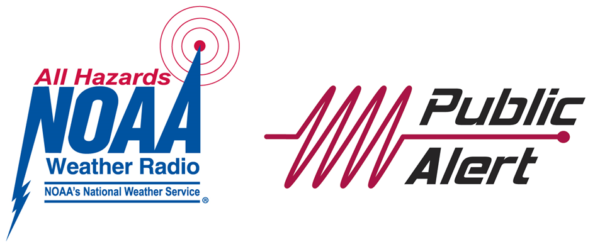
Localized Weather Alerts?
You may want the next level of protection provided by SAME, or Specific Area Message Encoding. It allows you to program your county and surrounding counties for increased warning time. SAME receivers will only receive alerts from the areas you have programmed.
SAME alerts can be transmitted via text or with a tone. Some radios even have a jack where you can plug in additional signaling devices like strobe lights or bed shakers. You’ll see an example of a SAME radio in the chart below.
Interested in Short Wave?
Many emergency radios also offer short wave reception – sometimes labeled SW1 and SW2. Having shortwave will extend your reach and add a few dollars to the price of your radio. Generally, inexpensive shortwave radios will be limited in their reach and quality of reception.
Being able to TALK via short wave is another feature altogether, and you may need to get licensed as a Ham radio operator. Here are Ham radio details.
Sole or Multiple Power Sources?
In an emergency, your radio NEEDS TO WORK! (Be sure to test it regularly.) Over the past several years, a number of good, inexpensive radios have come on the market that connect to multiple power sources. Look for most if not ALL of these power sources in your radio:
- Hand-crank – essential (but tiring)!
- Plug into the wall (AC)
- Plug into computer (or plug a phone into the radio) using a USB
- Power by batteries (DC) (rechargeable or regular)
- Power using external “power bank”
- Power using built-in or attachable solar panel
Many emergency radios come these days with “power banks” (exterior batteries) that can be recharged at the wall. Or the banks can be purchased separately. Power banks come in different shapes and sizes; prices depend mostly on the capacity of the battery, measured in mAh (milliAmp hours). Sizes usually start at 2000 mAh, with a price lower than $10. Take a look here for more about power banks.
Specialty Needs or Desires?
- Looking for a light or flashlight? How big and how bright? An emergency strobe light? The best emergency radios are multi-purpose pieces of equipment, and a good light is desirable.
- Does the radio have a siren or glow-in-the-dark feature to help you find it and people find you?
- How big and how heavy is the radio? How sturdy? Waterproof? How packable (rounded edges)?
- Have other devices to power? If your radio has plenty of batteries, you may want to use it to power up a phone or tablet, even run a DVD player.
WARNING: As mobile phones and computers continue to evolve, the wired connectors between the emergency radio and YOUR device/s may not match. When your radio arrives, be sure to check right away for plug compatibility. If necessary, simply buy the right connector separately. It may add another $4-$15 to the price of your radio.
WARNING #2: Be sure you know what accessories are included with the radios. For example, specifications may say that the radio can be plugged into AC for charging. But if you see “AC Adapter optional” realize the adapter is not actually included in the package.
Emergency radio reviews chart
Here are comments about a number of our favorite radios. They will give you some idea of what to look for as you shop. As you will see, we continue to use Amazon.com as the best place to shop. It consistently has the best prices and a great deal of valuable feedback via customer questions and reviews. We are Amazon Affiliates and may receive a commission if you buy through our link; your price won’t be impacted, of course.
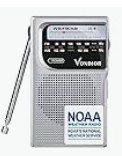
Still at the top of our list. No excuse not to have one handy!
You don’t know where you’ll be when an emergency hits. That’s why we like to have inexpensive small radios stashed around the house, ready at a moment’s notice.
Vondior offers a couple of palm-sized radios. The radios look pretty much the same, but check carefully. One is a regular AM/FM. The other, shown here, adds a NOAA Weather band. (Keep reading for more on that feature.) You can buy them separately or as a package.
I bought both and tested both with antenna full up, and found that the reception was every bit as good as our larger radios. (Be sure to move the radio and point the antenna in different directions to get the very best signal. I sat in my office chair and slowly spun in a circle to do my tests!) One extra that I particularly like: the red light that shows the radio is on.
Click here for more info and to order. (These make great gifts! Who do you know who needs one?)
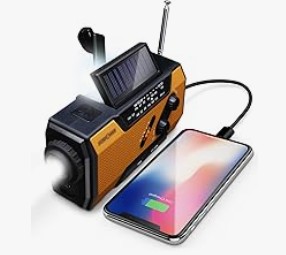
The next step up? a low-cost multi-power-source model!
There are plenty of different models to choose from in this category. The image shows a package from FosPower. It has loads of features: AM/FM, NOAA, SOS Alarm and Flashlight. Important for this review? The radio can be powered vis a USB computer connection, via a solar panel (on top), using batteries, and via a hand crank. And that multi-colored item attached by wire? It suggests that you could even use your radio to charge your phone!
Different radios come in different colors, too. (For some reason, fluorescent green is more expensive than orange!) Click on this link to review all these features at Amazon.
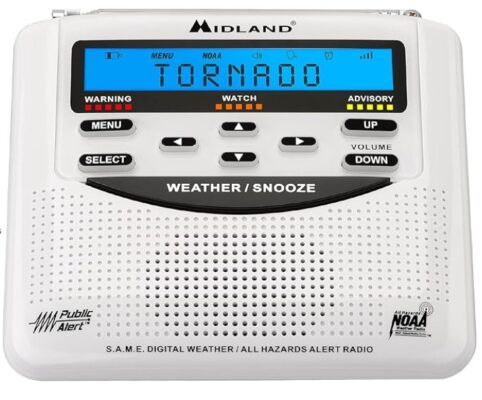
S.A.M.E. Technology as main feature.
We have used Midland products for years, mostly for our walkie talkies, so we are pleased to see this model emergency radio. It plugs into the wall, or runs on batteries when the power is out (Have extras handy!) but it has the S.A.M.E. technology that allow you to PROGRAM in weather alerts for your county and surrounding areas. (S.A.M.E. stands for Specific Area Message Encoding.) You can program this radio to get alerts for 60 different emergencies and select up to 25 locations for monitoring.
Keep it by the bed as a clock with snooze alarm — and when disaster approaches, you’ll know via a siren, voice alert and flashing LED. You can set the radio for how loud you want it.
Do you live in tornado county? Threated by wildfires? Always worried about flooding? Find out more about how this radio could save your life!
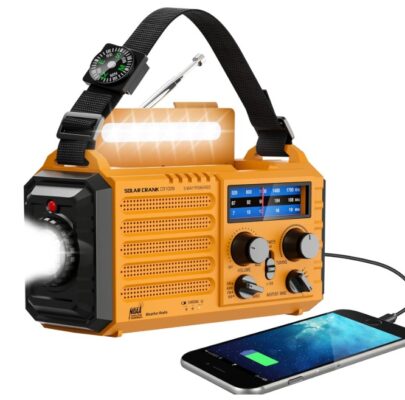
My favorite — for its lighting options!
I really like the Voyager by Kaito — for its feel and its lighting options. I am willing to pay extra just for those! The radio has a bank of LEDs for reading or ambient lighting (located underneath the solar panel), as well as a flashlight with red strobe.
At the top is the “patented 180-degree adjustable solar panel” — the largest solar panel of the lot. This radio also has an adjustable antenna, receives shortwave broadcasts SW1 and SW2, and has an easy to read and easily adjustable display. Ear plug capability means you’ll get even better reception.
The Kaito I bought a few years ago had five way power: AC/DC adapter, AA batteries plus built-in rechargeable Ni-MH battery, hand crank, solar and computer. (Its crank is a strange dog-leg shape but it seems to work perfectly well.) Note that this year’s model takes AAA batteries – and is designed to power your phone, too.
The “Voyager” comes in different colors, and there are a couple of slightly different models, so check carefully to be sure you are ordering what you thought you were ordering! Click here to see all the options.
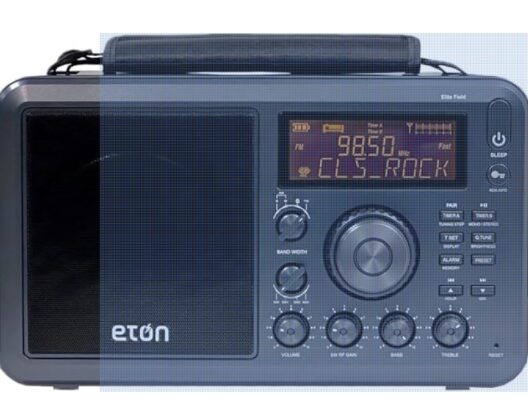
Want to follow worldwide happenings?
Many of us have friends and relatives across the globe, and when we hear about disasters we’d like to know the details. That’s where a better quality short-wave radio comes in.
This receiver from Eton (formerly from Grundig!) gets AM, FM, (with RDS), and Shortwave bands – and HD Radio in North America. And unlike less expensive radios, you can program in 50 of the channels you want to listen to.
Of course, there’s more than just news on your shortwave radio. You may be able to tune in on ships at sea, international weather broadcasts, and Ham radio operators from around the world. (Again, listening is “free.” Broadcasting via ham radio requires different equipment and a license.) (Joe has written an Advisory with more info about ham radios.)T
Some notes about shortwave. These signals “skip” across the earth and reception can vary dramatically depending where you have your radio in the house, what weather conditions are like, the quality of your antenna, what time of day you’re listening, etc. Don’t be discouraged if you don’t get much when you first turn it on — plan to spend some time learning to adjust the signal. (This ratio offers coarse and fine digital tuning.) And adding an extra antenna to any shortwave radio makes sense.
As you can see, this probably isn’t the small, light-weight radio you’d want to pack in your emergency bag. But for comprehensive coverage, check it out!
Now as for our last radio. Here’s the picture. Note the red X!
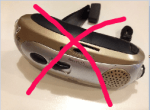
This hand-held radio was a disappointment.
I’ve included this picture because it holds fond memories. It was the very first hand-crank radio we bought, probably around 2003. It was inexpensive, looked great and was extremely handy to tuck in the door or glove compartment. Today, there are other compact light/radios on the market, too. Some of them operate just by squeezing the handle!
I urge caution with these small, hand-crank radios, based on my own experience. They may require pretty much constant cranking for you to get any signal or have much light. Still, the small size makes them attractive.
One final comment. Radios, like all electronic gadgets, continue to evolve. What you can buy this month may not be available next month, but don’t spend time waiting for the perfect emergency radio! When the emergency hits, you’ll want more than one to be sure you can get the information you need.
If you’re not sure which one to get, consider any one of the emergency radios listed above. Get one now, add to your collection later on as it becomes clearer what you really want.

Great insights! It’s crucial to stay prepared, and your updated reviews on emergency radios for 2025 really help narrow down the options. I didn’t realize how important features like NOAA channels and hand-crank power could be. Thanks for the detailed breakdown!
I have a Kaito KA500 radio. Here is a radio that features both a hand-crank generator and a battery alternative. Given that it also has a 5V AC/DC input, you can also use energy to power this device.
Tom, as you can see in the list above, I really like Kaito. We’ve had our Voyager for several years. As I said there, too, there are several different Kaito models! Thanks for bringing my attention to the KA500. Quite a difference in price between the KA500 and the KA600 — main difference seems to be the digital tuning. Worth reading carefully to get the one that fits your needs — and your pocketbook — best.
Very helpful indeed! However, I’ve found the handcrank feature to be more of a for show than how useful it really is. It doesn’t charge phones for long as I assume it takes up alot more power than just for the radio. What’s your take on solar over handcrank?
Kent, I have to agree about the inadequacies of handcrank as a useful power source. Better than noting, of course. As for solar, we have a couple of solar-powered radios and find that the solar works as an adjunct but isn’t really adequate for full-time power — even here in California. Much as the sustainability side of me hates to admit it, regular batteries are what we truly depend on. Lots and lots of them. Virginia
Have you seen this new crank radio? It plays for 2 hours from a 1 minute cranking. Wow. https://m.youtube.com/watch?v=HD8SWB4DQBc
I have to agree that hand-crank radios can be disappointing. A more efficient version would be welcome.
Overall this is helpful; however, why mix the hand-crank/solar radios with the non-crank/non-solar variety? As an example, I would have liked to see the C.Crane CC Solar Observer rated given that it’s more “apples to apples” with the competitors here.
At the end of the day, the usefulness comes down to reception on the AM band, where much of the emergency information will be found, and durability (ability to withstand the elements). In my own research, there are a lot of complaints of either A) proprietary or non-replaceable lithium batteries, and/or B) less-than-desirable results when these lithium-equipped hand-crank radios are left unattended for long periods.
Looking at the reviews for this kind of product online, they almost universally omit what kind of care the battery requires. As an example, the C.Crane Solar Observer would appear to require use throughout the year to maintain the battery charging capacity — and yet that’s inconsistent with the reality that most of these will be reserved for infrequent use in a bug-out bag or emergency kit.
I find myself wondering why, if manufacturers as far back as the late 1980s can make cordless phone batteries that maintain a decent amount of talk time and standby charge, the lithium batteries used in emergency radios tend to be short-lived per the reviews I’ve read (granted, the long-term owner review is a rarity). A related issue is that the over-charge circuit seems to be lacking in a lot of these radios, including the CC Solar Observer by C.Crane. What this means is that you can damage the battery by leaving it on the charger too long. It is unclear, at best, how many of the best-rated models even come equipped with a charge indicator light (indicating when it’s fully charged vs. time to recharge).
Overall, for the intended purpose — the harsh conditions of an emergency — I find that a lot of these products, throughout the price range, are deficient in some respect or another. How hard can it be to design something that is ruggedly built with a tuner that is not just “adequate” but offers stellar selectivity and sensitivity? After all, in an emergency it is possible for local stations to be evacuated or knocked offline — in which case it could be necessary for the radio to pull in more distant stations. This is why equipping an emergency product with an “average” AM/FM tuner won’t cut it. C.Crane at least has the tuner sensitivity right but their CC Solar Observer is not weatherized or particularly rugged and it’s not All Hazards or Public Alert certified, either. It’s discouraging to find that so many of these products demand significant trade-offs.
Dear LynnD,
Lots for thought in your comment. THANK YOU. And I must say that your input about battery care certainly agrees with my own experience. The challenge, as again you have noted, is that emergency radios tend to sit on the shelf for weeks and months without being used. Then, when they are wanted, the batteries are dead, corroded, worn out, whatever. A competent radio owner will be able to address many of the shortcomings you have noted, or shop with discrimination to avoid them in the first place. FYI, many of my readers are just getting started in assembling emergency equipment, so I tried to present a variety of styles and prices so people would have a better idea of what to look for — or perhaps, what to avoid.
I live in earthquake country in an area where residents have been told that it may take as many as 30 days for outside help to arrive following the so-called Big One (the 7.1 that shook much of Southern California was bad enough; a quake on the San Andreas would be ~100x stronger). As such, an emergency kit has to be available in the hot trunk of my car and another much larger kit is situated outside my home so that if the structure is damaged the emergency supplies do not become inaccessible. Outdoor and in-car storage conditions range from 20-110F degrees — none of which are easy on electronics/batteries much less the rest of the emergency supplies (the contents of a first aid kit also include heat-sensitive items for which I am also trying to arrive at a better solution to ensure they last through the summer let alone a year until they are refreshed!). That’s not to say a more long-lived rechargeable battery solution doesn’t exist — I have a eight-year-old hand-held ham radio that came out of my car after a year of such temperatures with a fully charged battery — only that the reliability level achievable in the hand-crank solar radio market is not quite there yet.
I have done hours of research for a durable hand-crank/solar radio for my emergency kit only to find that it is a surprisingly difficult choice. If lives depend on this equipment, manufacturers ought to put more effort into them so that being a “competent radio owner” is not the variable it currently is. (These products need to be both durable and idiot proof.) The CC Solar Observer is at the top of the list for a lot of people but it’s UL-rated for indoor/office use, per a sticker on the back, and the build quality reflects that. By no means would I talk anyone out of buying a solar/hand-crank radio — something on hand is always better than nothing! — but I also don’t think it hurts to pressure manufacturers to improve their offerings.
Not much to add to that strong recommendation! Thanks. I’ll pass along some of your comments to manufacturers every time I get the chance.